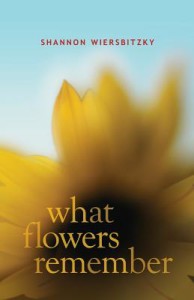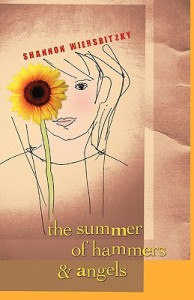Shannon Wiersbitsky and I first met several months ago at the 2015 NCTE conference where WHAT FLOWERS REMEMBER was honored by the Children’s Literature Assembly as one of 2015’s Notable Children’s Books in the English Language Arts. (Find more about What Flowers Remember HERE.) It’s a pleasure to welcome her back to ReaderKidZ to talk about her newest book.
DIANNE: The seeds of stories often come from an author’s personal experiences. You’ve written elsewhere that the inspiration for WHAT FLOWERS REMEMBER grew as the result of a loss in your own life. Can you talk about how that experience became the starting point for a story about Delia and her neighbors in the small town of Tucker’s Ferry?
SHANNON: I spent a lot of time with my grandparents growing up, they were like second parents. My grandfather developed Alzheimer’s and forgot me as the disease progressed. The day I realized he’d forgotten me is so vivid in my memory. I suppose in some ways I never really dealt with my own feelings and so the topic came out in my writing. We do write to heal ourselves, don’t we? I heard another author say that once and I believe its true.
Years ago I tried to write about the disease and the story simply didn’t work so I let it go. After my first novel, THE SUMMER OF HAMMERS AND ANGELS, was published, I thought I’d never write about my character Delia again. Then one day I was on a flight and the basic plot of WHAT FLOWERS REMEMBER came to me. I realized that the story of Alzheimer’s was hers I sketched out the entire story on the back of a travel itinerary. Every story has it’s own time I suppose.
DIANNE: When Delia and Old Red dream up a flower-selling business, the concept of seeds becomes more than a metaphorical construct. Old Red’s passion becomes Delia’s and his legacy is carried on through the very seeds and flowers they collected and cared for together.
As Old Red’s dementia worsens, Delia begins to record other memories from Old Red’s family and friends. She papers the walls of the nursing home where he lives with words and pictures, helping all who know Old Red honor him, while also coming to terms with his decline.
These are two powerful and tangible ways Delia is able to process Old Red’s decline. But, such opportunities may not always present themselves to a young person watching a loved one suffer the effects of dementia. In what other ways can the adults in a child’s life help?
SHANNON: This is a great question. People always ask me if I did all the great things Delia does and the answer is no. I didn’t think to do any of them! I do believe that kids (and adults honestly) could benefit from having some type of action. If the person impacted has not yet lost their ability to communicate, record them telling stories or answering questions about their life. Collect stories before they’re gone. Or create new memories, pick an activity that both adult and child enjoy and find time to do it. Know the handprint art that kids make in grade school? Handprints, large to small, layered one over another can be a lovely project. Or you might try one of the activities listed on the AllyBallyBee project.
 The biggest thing that adults can do though, both for themselves and for children, is to talk. As a society, there is so much shame related to Alzheimer’s. As if being forgotten means that we weren’t loved “enough”. And it is simply not true. So let children share and ask whatever questions are on their mind. Open dialogue, even when you don’t have the answers, is therapeutic.
The biggest thing that adults can do though, both for themselves and for children, is to talk. As a society, there is so much shame related to Alzheimer’s. As if being forgotten means that we weren’t loved “enough”. And it is simply not true. So let children share and ask whatever questions are on their mind. Open dialogue, even when you don’t have the answers, is therapeutic.
Because of the novel, I now talk about Alzheimer’s regularly. I’ve been shocked at the number of people I know who have been impacted by the disease. And yet we’d never discussed it before. Why? We must end the silence.
DIANNE: “Grief isn’t something you can rush…” Delia’s neighbor, Miss Martha, tells her. Over time, Delia learns to share the very brokenness and loss she feels over Old Red’s passing. She says, “I need to tell the stories about the flowers and the garden… even when the stories make me cry.
“When I’m silent, I can feel the cracks getting bigger, stretching wide and going deep. But when I talk, when there’s noise and sharing and laughter, something different happens. Bit by bit, I can feel those cracks filling up.”
It’s good advice for a young reader dealing with a loved one with Alzheimer’s. Can you suggest other resources (such as websites or blog posts) that readers can look to for more information?
SHANNON: These are two of my favorite passages of the book. It’s true isn’t it? Sharing stories about a loved one after they’ve gone can be so helpful.
There are a host of resources out there. These sites suggest a wide variety of books.
- http://www.alz.org/living_with_alzheimers_talking_to_kids_and_teens.asp
- https://www.alzheimers.org.uk/site/scripts/documents_info.php?documentID=108
- https://www.nia.nih.gov/alzheimers/resources-children-and-teens-about-alzheimers-disease
For teachers, consider discussing memory loss within the context of your curriculum.
Caroline Starr Rose hosted a blog with a few ideas related to my book.
- http://carolinestarrrose.com/classroom-connections-flowers-remember-shannon-wiersbitzky/
- Let Me Be Your Memory is a language arts program that focuses on storytelling and memory loss. http://letmebeyourmemory.net
There is also a reading guide for WHAT FLOWERS REMEMBER for church youth groups or Christian schools. It is available here. In addition to discussion questions, it also has activities suitable for individuals or groups, including a nifty little prayer rug.
DIANNE: What can readers expect next?
SHANNON: Well, I’ve been working on several picture books as well as two new middle grade novels. The novel is a comic adventure. I think I needed some humor after writing about such a tough topic.
DIANNE: Best wishes on your new endeavors and thanks for stopping by ReaderKidZ!
Discover more about Shannon HERE.











Thank you for shedding light on this topic and for what looks like a wonderful read, Diane. Shannon, my dad died of early onset Alzheimer’s at 68. I do remember when he forgot our names, could no longer walk, all of it. We began to play music from the Big Band era, bring the family dog to his care facility when it was permitted. Those acts helped us as much as they helped Dad, maybe they helped more!
Thanks for stopping by ReaderKidZ, Kathy. I know you’ll enjoy Shannon’s book and hope you’ll share it with others!